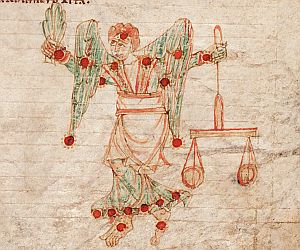
Star Lore Art
Aberystwyth Folios
11th Century


 |
Star Lore ArtAberystwyth Folios11th Century |

|


In 4 AD, Roman general and poet Germanicus wrote a Latin version of the
Phenomena, an an introduction to the constellations written by Greek poet
Aratus in the third century BC.
 Germanicus' treatise became the base of some of the oldest illuminated copies of astronomical text. Most famous one of all of these copies is the Leiden Aratea, created in the region of Lorraine in 816.  There have been a number of other copies preserved. The one presented here was probably produced in Limoges during the early years of the 11th century.  It contains several celestial maps and an incomplete text of the Germanicus Aratea with illustrations of the constellations in sepia ink with color washes and the stars marked.  The manuscript is now kept at the National Library of Wales in Aberystwyth.  The copies presented here were all taken from the public domain at Wikimedia.  A detailed description of all folios can be found at The Saxl Project.
We also included a print published by fineartamerica.com, only titled
"13th century medieval constellations."
|

|

 Folio 4r - Two Hemispheres
Folio 4r - Two Hemispheres
|
 Folio 5r - Winter Hemisphere
Folio 5r - Winter Hemisphere
|
 13th-century manuscript from fineartamerica.com
13th-century manuscript from fineartamerica.com
|


 Folio 13r
Folio 13rDraco, Ursa Major, Ursa Minor |
 Folio 13v
Folio 13vHercules |
 Folio 14v
Folio 14vSerpentius (Ophiuchus) and Scorpius |

 Folio 15r
Folio 15rBo÷tes |
 Folio 16r
Folio 16rVirgo |
 Folio 17r
Folio 17rGemini and Cancer |

 Folio 17v
Folio 17vLeo |
 Folio 18v
Folio 18vTaurus |
 Folio 19r
Folio 19rCepheus |

 Folio 19v
Folio 19vAndromeda |
 Folio 19v
Folio 19vCassiopeia |
 Folio 20r
Folio 20rPegasus |

 Folio 20v
Folio 20vAries |
 Folio 21r
Folio 21rHydra, Crater, Corvus, Canis Minor |
 Folio 21v
Folio 21vFive Planets |


| Some of the drawings are very similar to those of the Leiden Aratea, but it should be noted that contrary to the earlier Leiden Aratea, some of the constellation figures in the Aberystwyth collection are depicted back to front, as they would appear on a celestial globe. |
 Aries in Leiden Aratea Aries in Leiden Aratea |
 Aries in Aberystwyth Folios Aries in Aberystwyth Folios |


|
Back to Star Lore |
Back to Art |
Back to Space Page |
Back to English |
 Back to Start Page |